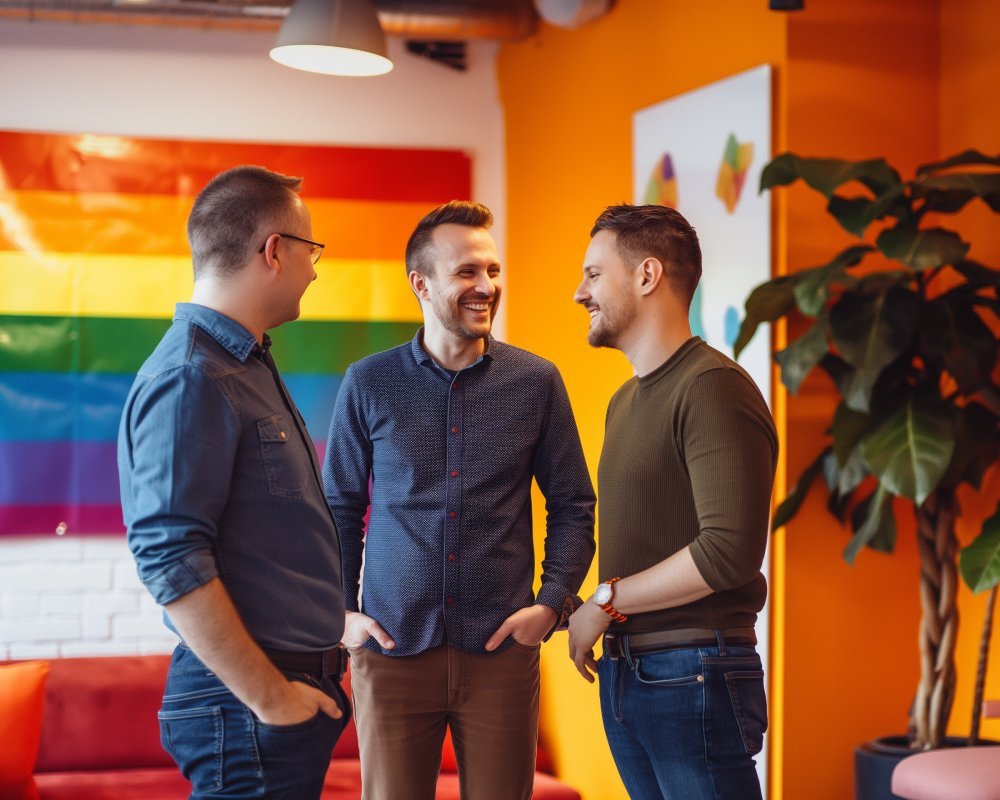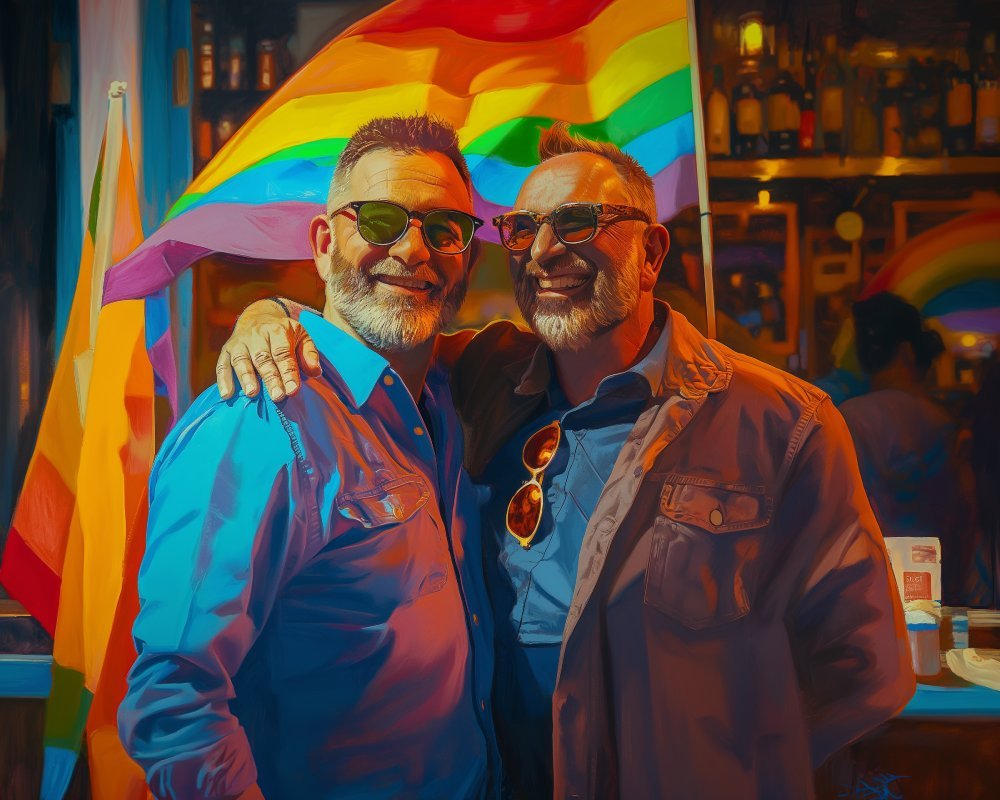
What Is the History Behind the Gay Rights Movement? – The gay rights movement has long and complex origins, a tapestry of struggles, triumphs, and ongoing quests for equality. This journey is rich with stories of courage, setbacks, and landmark moments that have shaped societal understanding and attitudes towards the LGBTQ+ community. From early instances of advocacy and underground gatherings to major legal victories and increased cultural acceptance, the movement continues to evolve and impact many lives today. To appreciate where the movement is now, it is crucial to understand its history, the individuals who have paved the way, and the society that has both challenged and embraced change. Operating at the forefront of this narrative, the Gay Thrive LGBTQ+ Marketing Agency uniquely positions itself as a beacon for LGBTQ+ visibility, helping businesses connect meaningfully with gay, lesbian, transgender, queer, and bi individuals. With this blog, we aim to explore “What Is the History Behind the Gay Rights Movement?” while highlighting key events and milestones over the decades.
The Early Years: A Seed for Change
In the late 19th and early 20th centuries, while homosexuality was largely condemned and even criminalized, seeds of the gay rights movement began to take root. Various individuals and groups stood up against societal norms and policies, championing queer rights and visibility in the face of widespread discrimination. Authors like Oscar Wilde, who faced legal battles due to their sexuality, played a crucial role by questioning societal prejudices through their work. In the 1920s, the Society for Human Rights was founded in Chicago—the first gay rights organization in the United States. Meanwhile, Germany witnessed the birth of the Scientific-Humanitarian Committee, attempting to reform laws against homosexuality. As our exploration of “What Is the History Behind the Gay Rights Movement?” unfolds, these early attempts illustrate the enduring spirit of those who dared to envision a world of acceptance and equality even amid adversity.

Post-War Activism: Building Visibility
The aftermath of World War II marked a shift in social dynamics and a burgeoning consciousness among the LGBTQ+ communities. During this era, significant challenges were met with concerted efforts to foster community and ignite change. The Mattachine Society, founded in 1950, and the Daughters of Bilitis, established in 1955, emerged as pioneering organizations advocating for gay and lesbian rights. These groups focused on rectifying misconceptions about homosexuality, promoting social acceptance, and supporting members facing prejudice. The LGBTQ+ magazine “ONE” was launched during this period, representing a powerful voice for a community pushed to the margins. Understanding “What Is the History Behind the Gay Rights Movement?” becomes clearer as we appreciate the critical groundwork laid during these years, laying the foundations for larger uprisings and pushing the boundaries of what was considered traditionally acceptable.
Advertisement · Scroll to continue
Recommended
The 1960s: A Decade of Revolt and Resilience
The 1960s marked a pivotal decade where resistance turned into resilience and visibility transformed into vocal demands for equality. The LGBTQ+ community began reclaiming spaces and establishing themselves as a force to be reckoned with, sparking movements for legal and social change. The famous Cooper Donuts raid of 1959 and the Compton’s Cafeteria riot in 1966 showcased growing discontent with oppressive law enforcement tactics against gay, lesbian, transgender, and queer individuals. However, it was the Stonewall Riots of 1969 in New York City that significantly amplified the movement worldwide, serving as a catalyst for the modern fight for LGBTQ+ rights. We delve deeper into “What Is the History Behind the Gay Rights Movement?” by recognizing the 1960s as the decade where the identification and assertion of fundamental rights became a collective goal, challenging societal norms more than ever before.

Stonewall Riots: A Turning Point
The significance of the Stonewall Riots in “What Is the History Behind the Gay Rights Movement?” cannot be overstated. On June 28, 1969, patrons of the Stonewall Inn, a gay bar in Greenwich Village, spontaneously rose against police brutality after a routine raid. The following days witnessed unprecedented activism, as protests erupted across New York City, setting off a nationwide movement for LGBTQ+ equality. Stonewall not only galvanized existing organizations but also inspired the creation of new advocacy groups, pushing forward legislation, awareness, and societal change. This pivotal event led to the formation of the Gay Liberation Front and the commencement of annual gay pride marches—now celebrated worldwide. Stonewall remains a testament to the power of united resistance and is memorialized as a symbol of defiance in the face of discrimination and oppression.
The 1970s: Demanding Rights and Representation
The momentum generated by the Stonewall Riots carried the LGBTQ+ movement into the 1970s with increased calls for recognition and representation. Gay, lesbian, transgender, queer, and bi individuals, bolstered by the spirit of the 1960s’ activism, continued to press for equal rights. In 1973, the American Psychiatric Association removed homosexuality from its list of mental disorders, marking a milestone in breaking away from harmful stereotypes. Harvey Milk, the first openly gay elected official in California, became an emblem of hope and change before his untimely assassination in 1978. The decade saw the proliferation of local organizations pushing for rights, culminating in the first Gay and Lesbian March on Washington in 1979. As we examine “What Is the History Behind the Gay Rights Movement?”, the 1970s stand out as a decade of remarkable social and legislative progress, laying crucial groundwork for the challenges still to come.

Advertisement · Scroll to continue
Recommended
Challenges and Triumphs in the 1980s and 1990s
The emergence of the AIDS epidemic in the 1980s brought new challenges, fears, and stigmatization to the LGBTQ+ community. Misconceptions and discriminatory policies exacerbated the suffering of millions globally. Amid this, passionate activism rose, with organizations like ACT UP demanding government action, increased awareness, and funding for research. Despite these daunting hurdles, significant victories were achieved, notably, the election of LGBTQ+ officials such as Barney Frank. Landmark legislation, including the Americans with Disabilities Act, offered protections for those living with HIV/AIDS. The 1990s heralded further progress with the overturning of anti-sodomy laws in several states and initial steps towards same-sex partnership recognition. Understanding “What Is the History Behind the Gay Rights Movement?” requires acknowledging the balance of challenges and resilience demonstrated during these pivotal decades, where community strength and tenacity reigned supreme.
The New Millennium: Sweeping Reforms and Cultural Shifts
As the 21st century dawned, the gay rights movement increasingly became mainstream, resulting in sweeping political and cultural changes. The visibility of gay, lesbian, transgender, queer, and bi individuals in media, politics, and public life shifted societal perceptions and contributed to significant progress. A landmark victory occurred when the Netherlands became the first country to legalize same-sex marriage in 2001, paving the way for numerous countries to follow. Over the next two decades, the landmark Obergefell v. Hodges ruling by the U.S. Supreme Court in 2015 legalized same-sex marriage nationwide, representing a triumph for equality. Meanwhile, advocacy for transgender rights, healthcare, and antidiscrimination laws has continued to evolve. Exploring “What Is the History Behind the Gay Rights Movement?” helps envision a future where inclusion, respect, and universal human rights become truly accessible to all.

Modern-Day Challenges and Continued Advocacy
Despite formidable progress, numerous challenges remain for the LGBTQ+ community, urging continued activism and solidarity. Discrimination and prejudice persist globally, with certain regions implementing anti-gay legislation and witnessing acts of violence against LGBTQ+ individuals. The fight for transgender rights, equity in the workplace, and healthcare access remains at the forefront of modern advocacy. Within this context, Gay Thrive LGBTQ+ Marketing Agency plays a crucial role by empowering visibility and connection—helping businesses resonate with diverse communities effectively. As we analyze “What Is the History Behind the Gay Rights Movement?”, the urgency for continued education and allyship is evident. By understanding the history and ongoing struggles, society is better equipped to champion a future of equality and pride, ensuring each individual is afforded the dignity and respect they deserve.
Conclusion: The Road Ahead
Reflecting on “What Is the History Behind the Gay Rights Movement?” reveals a path punctuated by bravery, resistance, and progress. It exemplifies the power of collective voices in challenging injustices and inspiring significant global change. Both individuals and organizations empowered by this history continue to drive forward conversations, policies, and initiatives that align with the principles of dignity and diversity. The Gay Thrive LGBTQ+ Marketing Agency echoes this sentiment by championing visibility and fostering connections that respect and support the gay, lesbian, transgender, queer, and bi communities. As the movement for equality presses on, let us continue to remember and honor the legacy of those who have paved the way, while remaining committed to a world where love and acceptance triumph over bigotry and hatred.
Advertisement · Scroll to continue

More Recommended
200+ Funny Trans Jokes: Transgender Jokes
200+ Funny Trans Jokes: Transgender Jokes That Celebrate Identity with Laughter – Explore 200+ funny, [...]
How to Support Gay Friends and Family Members
How to Support Gay Friends and Family Members – Supporting gay friends and family members [...]
Pride Month Marketing Strategies for Gay-Owned Businesses
Beyond Pride Month: Celebrating and Supporting Gay-Owned Businesses Through Strategic Marketing As Pride Month comes [...]
Olivia Cruises Offers Escape for Lesbian Travelers
Olivia Cruises Offers Escape for Lesbian Travelers – Are you a lesbian traveler looking for [...]
How do you show inclusiveness at work?
How do you show inclusiveness at work? – In today’s globalized and diverse workforce, fostering [...]
How to Create a Gay-Friendly Social Environment
How to Create a Gay-Friendly Social Environment – Creating a gay-friendly social environment is not [...]
Marketing to the LGBTQ Community: Strategies for Success
Marketing to the LGBTQ Community: Strategies for Success – to headers as you write the [...]
How to make workplace LGBT friendly?
How to make workplace LGBT friendly? – Creating an LGBT-friendly workplace is essential for fostering [...]
The Power of Gay Voices in Literature
The Power of Gay Voices in Literature – Literature has always been a powerful medium [...]